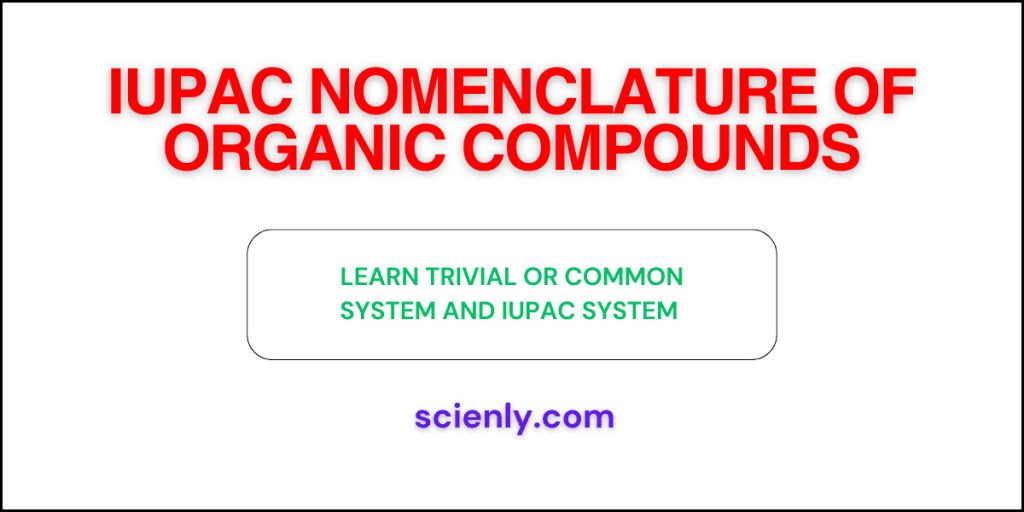IUPAC Nomenclature of Organic Compounds
In this article, we will explore the basics of IUPAC nomenclature of organic compounds with rules and step-by-step examples. Organic chemistry deals with million of organic compounds containing carbon as an essential element. Before the IUPAC system of nomenclature, the organic compounds were often named based on the source from which they were first prepared. For example, urea was named because it was first isolated from the urine of mammals.
Similarly, acetic acid was first obtained from vinegar. Its name comes from the Latin word acetum, meaning vinegar. The name formic acid was derived from the Latin word formica, meaning ant, because it was originally isolated from red ants.
Remembering the names of each individual is a difficult task. Therefore, these compounds are named according to a systematic method called nomenclature. The term nomenclature means the system of naming organic compounds. In the case of aliphatic compounds, two systems of nomenclature are generally used:
- Trivial or Common system
- IUPAC system

Trivial or Common System
This method of nomenclature was used in the early stages of the development of organic chemistry. In this system, the compounds were named based on their source or their properties. For example, citric acid is named because it is found in citrus fruits. Similarly, methyl alcohol was called wood spirit because it was obtained by the destructive distillation of wood. These names of organic compounds are called common names or trivial names. They are still in use for some organic compounds. Common or trivial names of some organic compounds are given below:
- CH4 – Methane
- C2H2 – Acetylene
- CH3COOH – Acetic acid
- CH3CONH2 – Acetamide
- CH3CN – Acetonitrile
- C6H6 – Benzene
- C6H5CH3 – Toluene
- C6H5OH – Phenol
- CHCl3 – Chloroform
- HCHO – Formaldehyde
IUPAC System
Carbon forms a large number of organic compounds because of its unique properties of catenation and isomerism. Even towards the end of 19th century, the number of known organic compounds had become so large that it was difficult to remember them by their common or trivial names.
To systematize the nomenclature of organic compounds, an International Congress of Chemists was held at Geneva in 1892. The system developed there was also called the Geneva system. This system was further improved in 1930 by the International Union of Chemists. This improved system is referred to as IUC system.
In 1958, the IUC system had been further revised by the International Union of Pure and Applied Chemistry. It is abbreviated as IUPAC system of nomenclature. This revised system of nomenclature has been accepted all over the world.
The first comprehensive set of rules for the nomenclature of organic compounds was prepared by IUPAC in 1979. Based on regular feedback from chemists worldwide, these rules were revised and updated in 1993. The nomenclature of organic compounds presented here follows the 1993 IUPAC recommendations.
General Rules for IUPAC Nomenclature of Organic Compounds
IUPAC nomenclature is a systematic and standardized set of rules developed by the International Union of Pure and Applied Chemistry (IUPAC) for naming organic compounds. It is the most rational and widely used system of nomenclature in organic chemistry. The most important feature of this system is that
- Any given molecular structure has only one IUPAC name, and any given IUPAC name corresponds to only one molecular structure.
According to the IUPAC system of nomenclature, the name of any organic compound consists of three parts:
- Word root
- Suffix
- Prefix
Word Root
The word root is the basic unit of the name. It represents the number of carbon atoms present in the parent chain. The parent chain is the longest possible continuous chain of carbon atoms, including the principal functional group and any multiple bonds, if present. Special word roots are used for chains containing one to four carbon atoms, while Greek-derived number roots are used for chains containing five or more carbon atoms.
The word roots for different lengths of carbon chains is given below in the table:
| Number of Carbon Atoms (Chain Length) | Word Root |
|---|---|
| 1 | Meth- |
| 2 | Eth- |
| 3 | Prop (a)- |
| 4 | But (a)- |
| 5 | Pent (a)- |
| 6 | Hex (a)- |
| 7 | Hept (a)- |
| 8 | Oct (a)- |
| 9 | Non (a)- |
| 10 | Dec (a)- |
| 11 | Undec (a)- |
| 12 | Dodec (a)- |
The extra “a” given in the parentheses is used only when the primary suffix to be added to the word root begins with a consonant. In general, the word root for any carbon chain is alk, which represents a saturated hydrocarbon chain.
Suffix
There are two types of suffix:
- Primary suffix
- Secondary suffix
(1) Primary Suffix
The primary suffix denotes the type of bonding (linkages) between the carbon atoms. It is always added to the word root to denote whether the carbon chain is saturated or unsaturated. The three basic primary suffixes are given below:
| Type of carbon chain | Primary suffix | General names |
|---|---|---|
| (a) Saturated (containing single bonds only) | -ane | Alkane |
| (b) Unsaturated with one double bond | -ene | Alkene |
| (c) Unsaturated with one triple bond | -yne | Alkyne |
If the parent carbon chain contains two, three, four, or more double or triple bonds, we add numerical prefixes such as di (for two), tri (for three), tetra (for four), etc. to the primary suffix. For example,
| Type of carbon chain | Primary suffix | General name |
|---|---|---|
| (a) Unsaturated with two double bonds | -diene | Alkadiene |
| (b) Unsaturated with two triple bonds | -diyne | Alkadiyne |
Following are the examples that use the word roots and primary suffix in naming organic compounds:
| Organic compounds | Word root | Primary suffix | IUPAC name |
|---|---|---|---|
| 1. CH3CH2CH2CH3 | But | ane | Butane |
| 2. CH3CH=CH2 | Prop | ene | Propene |
| 3. CH≡CH | Eth | yne | Ethyne |
| 4. CH2=CH-CH=CH2 | Buta* | diene | Butadiene |
| 5. HC≡C-C≡CH | Buta* | diyne | Butadiyne |
(2) Secondary Suffix
A secondary suffix is used to indicate the nature of the functional group present in the organic compounds. Secondary suffixes of some important functional groups are given below:
| Class of organic compounds | Functional group | Secondary suffix |
|---|---|---|
| 1. Alcohols | -OH | -ol |
| 2. Aldehydes | -CHO | -al |
| 3. Ketones | >C=O | -one |
| 4. Carboxylic acids | -COOH | -oic acid |
| 5. Acid amides | -CONH2 | -amide |
| 6. Acid chloride | -COCl | -oyl chloride |
| 7. Esters | -COOR | alkyl . . .oate |
| 8. Nitriles | -CN | nitrile |
| 9. Thiol | -SH | thiol |
| 10. Amines | -NH2 | amine |
Important Note: When a secondary suffix is added to a primary suffix (such as –ane, –ene, or –yne), the terminal “e” of the primary suffix is dropped if the secondary suffix begins with a vowel, but it is retained if the secondary suffix begins with a consonant.
Following are the examples of using word root, primary suffix, and secondary suffix in naming of organic compounds:
| Organic compound | Word root | Primary suffix | Secondary suffix | IUPAC names |
|---|---|---|---|---|
| 1. CH3CH2OH | Eth | an (e)* | ol | Ethanol |
| 2. CH3CH2CH2NH2 | Prop | an (e)* | amine | Propanamine |
| 3. CH3CH2CH2COOH | But | an (e)* | oic acid | Butanoic acid |
| 4. CH3CH2CN | Prop | ane | nitrile | Propanenitrile |
| 5. CH2=CHCHO | Prop | en (e)* | al | Prop-2-en-1-al |
| 6. HC≡CCOOH | Prop | yn (e)* | oic acid | Prop-2-yn-1-oic-acid |
In the above example, the terminal ‘e’ from the primary suffix has been dropped because the secondary suffix begins with a vowel.
Prefix
Prefix is a part of IUPAC name that appears before the word root. There are two types of prefixes:
- Primary prefix
- Secondary prefix
(1) Primary prefix
A primary prefix is used to distinguish between cyclic compounds and acyclic (open-chain) compounds. If the compound is cyclic, the prefix “cyclo-” is placed immediately before the word root. For example, in carbocyclic compounds, the prefix cyclo- is written directly before the word root, such as in cyclopentane. In the example of cyclopentane,
- Primary prefix – Cyclo
- Word root – pent
- Primary suffix – ane
- IUPAC name – Cyclopentane
If the primary prefix cyclo is not used in the name of an organic compound, it simply indicates that the compound is acyclic or open chain.
(2) Secondary prefix
In the IUPAC nomenclature, some groups are not treated as principal functional groups. Such groups are considered as the substituents. Each such group (or substituent) is denoted by a secondary prefix. Some common secondary prefixes used in IUPAC nomenclature are listed below:
| Substituent group | Secondary group |
|---|---|
| -F | Fluoro |
| -Cl | Chloro |
| -Br | Bromo |
| -I | Iodo |
| -NO2 | Nitro |
| -NO | Nitroso |
| -N+ ≡ N | Diazo |
| -OR | Alkoxy |
| OCH3 (-OMe) | Methoxy |
| -OC2H5 (-OEt) | Ethoxy |
| -CH3 (-Me) | Methyl |
| -C2H5 (-Et) | Ethyl |
| -CH2CH2CH3 (n-Pr) | n-Propyl |
| -CH(CH3)2 (-iPr) | Isopropyl |
| -C(CH3)3 | tert-Butyl |
You should follow the following rules while adding a secondary prefix.
- For alicyclic (cyclic) compounds:
- The secondary prefix (substituent) is added immediately before the primary prefix (i.e. before the word cyclo) in the alphabetical order.
- Example: 1-bromo-3-methylcyclohexane
- For open-chain (acyclic) compounds:
- The secondary prefix is added immediately before the word root (longest carbon chain) in the alphabetical order.
- Example: 2-chloro-3-methylbutane
In addition to these, other functional groups are also considered as substituent groups in case of polyfunctional compounds. Thus, the complement IUPAC name of an organic compound consists of the following parts:
Secondary prefix + Primary prefix + Word root + Primary suffix + Secondary suffix
Here are some examples that illustrate the use of word root, primary and secondary prefixes and suffixes in the naming organic compounds:
| Organic compound | Secondary prefix | Word root | Primary suffix | IUPAC name |
|---|---|---|---|---|
| 1. CH3CH2Br | Bromo | eth | ane | Bromoethane |
| 2. CH3NO2 | Nitro | meth | ane | Nitromethane |
| 3. C2H5OC2H5 | Ethoxy | eth | ane | Ethoxyethane |






